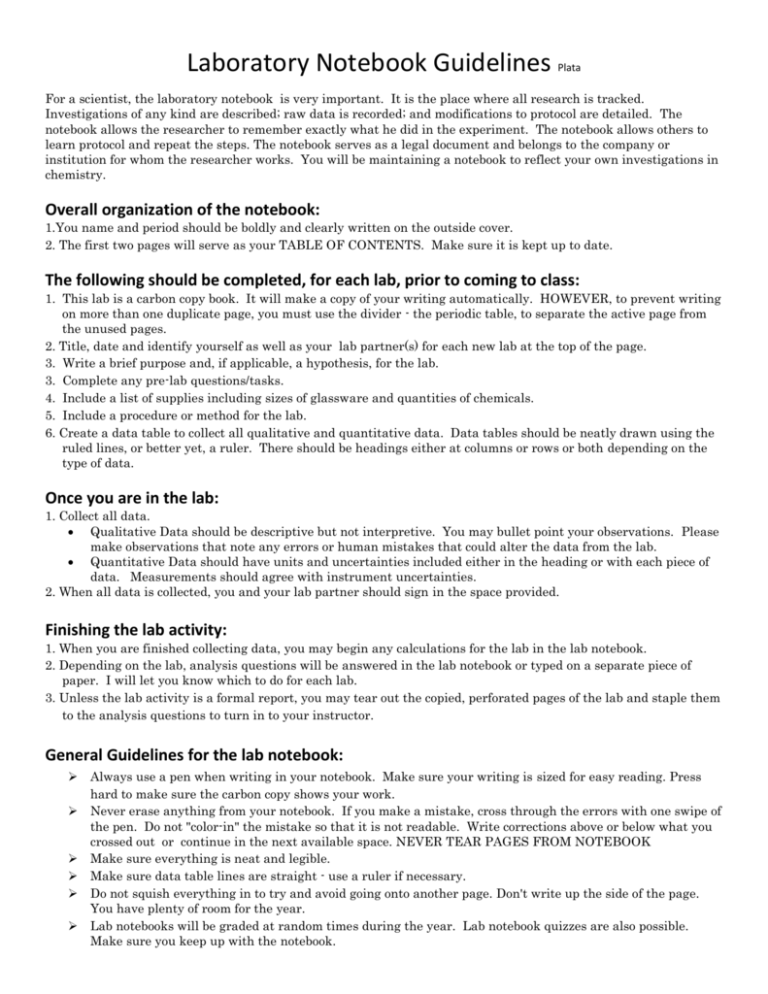General Guidelines for the lab notebook
advertisement

Laboratory Notebook Guidelines Plata For a scientist, the laboratory notebook is very important. It is the place where all research is tracked. Investigations of any kind are described; raw data is recorded; and modifications to protocol are detailed. The notebook allows the researcher to remember exactly what he did in the experiment. The notebook allows others to learn protocol and repeat the steps. The notebook serves as a legal document and belongs to the company or institution for whom the researcher works. You will be maintaining a notebook to reflect your own investigations in chemistry. Overall organization of the notebook: 1.You name and period should be boldly and clearly written on the outside cover. 2. The first two pages will serve as your TABLE OF CONTENTS. Make sure it is kept up to date. The following should be completed, for each lab, prior to coming to class: 1. This lab is a carbon copy book. It will make a copy of your writing automatically. HOWEVER, to prevent writing on more than one duplicate page, you must use the divider - the periodic table, to separate the active page from the unused pages. 2. Title, date and identify yourself as well as your lab partner(s) for each new lab at the top of the page. 3. Write a brief purpose and, if applicable, a hypothesis, for the lab. 3. Complete any pre-lab questions/tasks. 4. Include a list of supplies including sizes of glassware and quantities of chemicals. 5. Include a procedure or method for the lab. 6. Create a data table to collect all qualitative and quantitative data. Data tables should be neatly drawn using the ruled lines, or better yet, a ruler. There should be headings either at columns or rows or both depending on the type of data. Once you are in the lab: 1. Collect all data. Qualitative Data should be descriptive but not interpretive. You may bullet point your observations. Please make observations that note any errors or human mistakes that could alter the data from the lab. Quantitative Data should have units and uncertainties included either in the heading or with each piece of data. Measurements should agree with instrument uncertainties. 2. When all data is collected, you and your lab partner should sign in the space provided. Finishing the lab activity: 1. When you are finished collecting data, you may begin any calculations for the lab in the lab notebook. 2. Depending on the lab, analysis questions will be answered in the lab notebook or typed on a separate piece of paper. I will let you know which to do for each lab. 3. Unless the lab activity is a formal report, you may tear out the copied, perforated pages of the lab and staple them to the analysis questions to turn in to your instructor. General Guidelines for the lab notebook: Always use a pen when writing in your notebook. Make sure your writing is sized for easy reading. Press hard to make sure the carbon copy shows your work. Never erase anything from your notebook. If you make a mistake, cross through the errors with one swipe of the pen. Do not "color-in" the mistake so that it is not readable. Write corrections above or below what you crossed out or continue in the next available space. NEVER TEAR PAGES FROM NOTEBOOK Make sure everything is neat and legible. Make sure data table lines are straight - use a ruler if necessary. Do not squish everything in to try and avoid going onto another page. Don't write up the side of the page. You have plenty of room for the year. Lab notebooks will be graded at random times during the year. Lab notebook quizzes are also possible. Make sure you keep up with the notebook. Laboratory Notebook Critique Expectation Name on Outside - easy to see (use a sharpie) Table of Contents up to date, page numbers, titles, dates Points Possible 0.5 1 Organization of Lab used pen, always begin on right page, title, date, page number; easy to read print, corrections are done neatly, written at time of lab and not after the fact 1 Prelab Assignments completed prior to coming to class as evidenced by it fitting nicely into the allotted space - not cramped, not extra Purpose describes reason for doing the lab in own words written prior to class; hypothesis if applicable 1 0.5 Procedure can follow what was done (i.e. changes to procedure are acceptable), written clearly, in steps, includes chemicals, quantities, sizes of equipment 2 Data Table In boxed tables, lines drawn, labels, size appropriate organized well and neat Quantitative data includes units, uncertainty measurements agree with uncertainties Qualitative data No calculations are included (only measured values, not derived values) 2 Calculations Descriptor included for each type of calculation. Algebraic equation with needed variable isolated. Units and labels included. All trials included. Answers clearly circled or boxed. Signatures at end of each lab TOTAL POINTS 1 1 10 Points Earned









